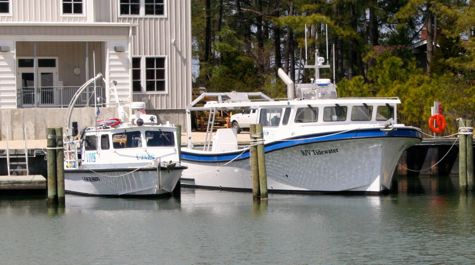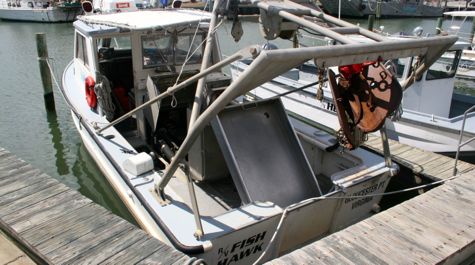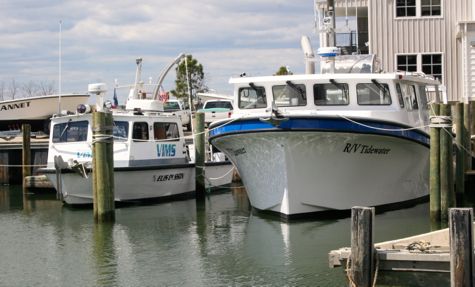VIMS upgrades research fleet with R/V Tidewater
The Virginia Institute of Marine Science has taken ownership of a new research vessel, the 43-foot R/V Tidewater, which will replace the 29-foot R/V Fish Hawk as the primary platform for VIMS’ juvenile-fish abundance surveys.
Survey researchers have been estimating the abundance and distribution of fish and blue crabs in Chesapeake Bay since 1955, with the R/V Fish Hawk in use since 1990. Data from the surveys—now collected on a monthly basis—help guide sustainable management of the Bay’s commercially, recreationally, and ecologically important marine life.
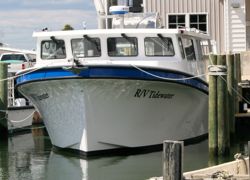 Captain Durand Ward, interim marine superintendent at VIMS, says the upgrade to a newer, larger vessel is long overdue. “The Fish Hawk has been in heavy service for more than 20 years,” says Ward, “In 2012 alone, it racked up more than 1,000 service hours during 135 days at sea.”
Captain Durand Ward, interim marine superintendent at VIMS, says the upgrade to a newer, larger vessel is long overdue. “The Fish Hawk has been in heavy service for more than 20 years,” says Ward, “In 2012 alone, it racked up more than 1,000 service hours during 135 days at sea.”
Associate Professor Mary Fabrizio, who oversees VIMS’ trawl and seine surveys, is eager to see the new vessel put into operation, noting that it will enhance both field capabilities and crew comfort.
“The Tidewater has greater stability, increased freeboard, and a bow design that throws water away from the windows,” says Fabrizio. “The increased length and beam will allow us to operate in conditions we would not have considered with the Fish Hawk. That will reduce days lost to weather and give some flexibility to our sampling schedule.”
Dr. John Wells, VIMS Dean and Director, is excited to bring the state-of-the-art vessel into the VIMS research fleet. “Although the Tidewater’s primary use will be for the juvenile survey,” says Wells, “it was designed with the broader interests of the VIMS community to allow us to accomplish whatever tasks are needed to serve the Commonwealth.”
Dr. Troy Tuckey, who manages the day-to-day operation of VIMS’ juvenile-fish abundance surveys, notes that the survey team averages every third day on the water—in winter’s chill, summer’s heat, and winds up to 15 knots—making the new vessel’s capabilities and amenities particularly important for crew efficiency, safety, and comfort.
“During a survey cruise, we’re on the water 8 to 9 hours every day,” says Tuckey. “We sample at 12 to 14 different stations each day, collecting around 500 fish per tow. On a typical day we catch and release 6 to 7 thousand fish, so the placement of our sampling gear and the lay-out of the deck are really important.”
Fabrizio, Tuckey, and staff in the Field Operations Center at VIMS worked closely on the Tidewater’s layout and specifications with designers at Millennium Marine of Escuminac, New Brunswick, where the fiberglass vessel was built.
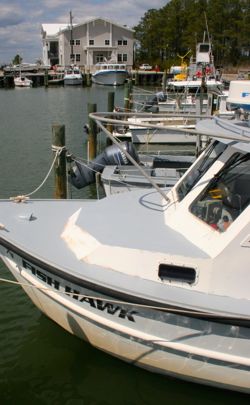 The Tidewater features a hydraulic A-frame for deploying trawl nets and other sampling equipment, ample storage for scientific and personal gear, an open rear deck for efficient sampling, and a separate enclosed space for lab work. Powered by a 715-hp diesel engine and a 4-blade propeller, it is capable of speeds up to 18 knots, with top-of-the-line electronics for navigation.
The Tidewater features a hydraulic A-frame for deploying trawl nets and other sampling equipment, ample storage for scientific and personal gear, an open rear deck for efficient sampling, and a separate enclosed space for lab work. Powered by a 715-hp diesel engine and a 4-blade propeller, it is capable of speeds up to 18 knots, with top-of-the-line electronics for navigation.
“The Tidewater’s hydraulic A-frame will provide lifting capabilities that the Fish Hawk simply can’t perform,”says Tuckey, “Its greater crew capacity—it can carry up to 8 people compared to 4 on the Fish Hawk—will allow us to collaborate with other investigators and even perform experiments at sea. The possibilities are wide open.”
VIMS researchers will continue to use the Fish Hawk for at least a year, running “comparison tows” between it and the Tidewater to adjust for changes in sampling efficiency between the vessels. “That’s really important to maintain the integrity of the long-term recruitment survey,” says Fabrizio.
“It was the dedication of trawl-survey and vessel-support staff that made it possible to safely and successfully use the Fish Hawk for so long,” says Tuckey, “but it’s not the ideal platform for trawling or for the conditions we experience in Chesapeake Bay. The Tidewater will enable us to ask new questions and develop research projects that weren’t previously possible. That’s very exciting.”

